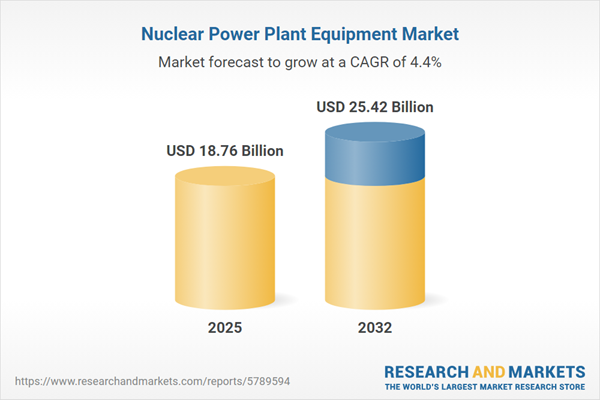Speak directly to the analyst to clarify any post sales queries you may have.
The Nuclear Power Plant Equipment Market continues to be a strategic focal point for organizations shaping the future of global energy infrastructure. As decarbonization efforts accelerate and safety standards grow more rigorous, senior leaders are faced with operational, regulatory, and supply chain considerations that demand robust, informed decision-making.
Market Snapshot: Nuclear Power Plant Equipment Market Trends and Growth
The global Nuclear Power Plant Equipment Market grew from USD 17.97 billion in 2024 to USD 18.76 billion in 2025. Sustained by a compound annual growth rate (CAGR) of 4.42%, the market is projected to reach USD 25.42 billion by 2032. Growth is driven by rising investments in nuclear infrastructure modernization, policy incentives for carbon-neutral energy, advancements in reactor technology, and evolving safety standards across established and emerging markets.
Scope & Segmentation: Core Segments, Regions, and Technology Focus
This report delivers detailed, actionable intelligence across every key segment of the Nuclear Power Plant Equipment Market:
- Reactor Components: Control rod drive mechanisms, pressure vessels, reactor internals, steam generators
- Turbine Systems: Generators, steam turbines
- Instrumentation and Control: Actuators, diagnostic systems, distributed control systems, programmable logic controllers, sensors (including flow, level, pressure, and temperature), software systems (maintenance, performance monitoring, reactor simulation)
- Cooling Systems: Cooling towers, heat exchangers (air cooled, plate, shell and tube), centrifugal pumps, positive displacement pumps, valves
- Safety Systems: Containment systems, emergency core cooling (high and low pressure injection systems), fire protection, radiation monitoring
- Fuel Handling Systems: Fuel assemblies, storage racks, transfer equipment
- Electrical Equipment: Cabling systems, switchgear, transformers, UPS systems
- Auxiliary Systems: Filtration, instrument air, miscellaneous equipment, piping, valves
Regional Coverage: Americas (including the United States, Canada, Mexico, Brazil, Argentina, Chile, Colombia, Peru), Europe, Middle East & Africa (including major European economies, Gulf nations, and key African states), and Asia-Pacific (China, India, Japan, Australia, South Korea, Southeast Asia, Taiwan)
Leading Companies Assessed: State Atomic Energy Corporation Rosatom, China National Nuclear Corporation, China General Nuclear Power Group, Westinghouse Electric Company, Framatome SA, GE Hitachi Nuclear Energy, Mitsubishi Heavy Industries, Toshiba Energy Systems & Solutions, BWX Technologies, Doosan Heavy Industries
Key Takeaways: Strategic Insights for Market Leadership
- Equipment reliability and predictive maintenance are increasingly central in nuclear plant operations. Modern platforms leverage advanced analytics and sensor integration for early anomaly detection and improved uptime.
- Regulatory environments are evolving, with heightened safety and transparency requirements prompting innovation in both component design and lifecycle management processes.
- Regional equipment demand profiles vary, with North America prioritizing life-extension of legacy reactors, EMEA focusing on digital retrofits, and Asia-Pacific driving growth through new construction and local content mandates.
- Market competition is defined by integrated service offerings, specialized technology innovation, and strategic partnerships—factors that enhance supply chain resilience and client engagement.
- Corporate strategies range from global expansion and vertically integrated servicing to highly targeted technology solutions, enabling diverse players to address market-specific challenges.
Tariff Impact: Navigating Shifting Supply Chains and Cost Structures
The introduction of United States tariffs in 2025 has generated substantial shifts within nuclear equipment supply chains. Some operators emphasize local fabrication and supplier diversification, while domestic manufacturers face both expansion opportunities and new challenges associated with quality protocols. International partnerships are adapting through joint ventures and shared investments to mitigate potential trade disruptions and build supply chain resilience.
Methodology & Data Sources: Comprehensive, Multi-source Intelligence
Primary interviews with industry experts, plant operators, equipment suppliers, and regulators are combined with secondary analysis of technical journals, certification records, regulatory filings, and vendor catalogs. Regional trends are mapped through project announcements, procurement datasets, and documented supply chain activities. Data credibility is ensured through rigorous validation and governance protocols.
Nuclear Power Plant Equipment Market: Why This Report Matters
- Gain actionable insights on technology shifts, procurement strategies, and emerging risks to inform critical capital allocation and partnership decisions.
- Understand nuanced regional market dynamics to better support portfolio expansion, compliance, and risk management initiatives.
- Benchmark corporate strategies and innovation leadership to identify potential investment or collaboration opportunities in a changing regulatory climate.
Conclusion: Forward-looking Perspective for Industry Stakeholders
The Nuclear Power Plant Equipment Market is at a pivotal juncture, influenced by technology advancements, shifting policy frameworks, and the demand for operational excellence. Organizations that align investment, innovation, and strategic collaboration are positioned to capture new opportunities in this evolving sector.
Additional Product Information:
- Purchase of this report includes 1 year online access with quarterly updates.
- This report can be updated on request. Please contact our Customer Experience team using the Ask a Question widget on our website.
Table of Contents
3. Executive Summary
4. Market Overview
7. Cumulative Impact of Artificial Intelligence 2025
Companies Mentioned
The companies profiled in this Nuclear Power Plant Equipment market report include:- State Atomic Energy Corporation Rosatom
- China National Nuclear Corporation
- China General Nuclear Power Group Co., Ltd
- Westinghouse Electric Company LLC
- Framatome SA
- GE Hitachi Nuclear Energy Limited
- Mitsubishi Heavy Industries, Ltd
- Toshiba Energy Systems & Solutions Corporation
- BWX Technologies, Inc.
- Doosan Heavy Industries & Construction Co., Ltd
Table Information
| Report Attribute | Details |
|---|---|
| No. of Pages | 195 |
| Published | October 2025 |
| Forecast Period | 2025 - 2032 |
| Estimated Market Value ( USD | $ 18.76 Billion |
| Forecasted Market Value ( USD | $ 25.42 Billion |
| Compound Annual Growth Rate | 4.4% |
| Regions Covered | Global |
| No. of Companies Mentioned | 11 |









